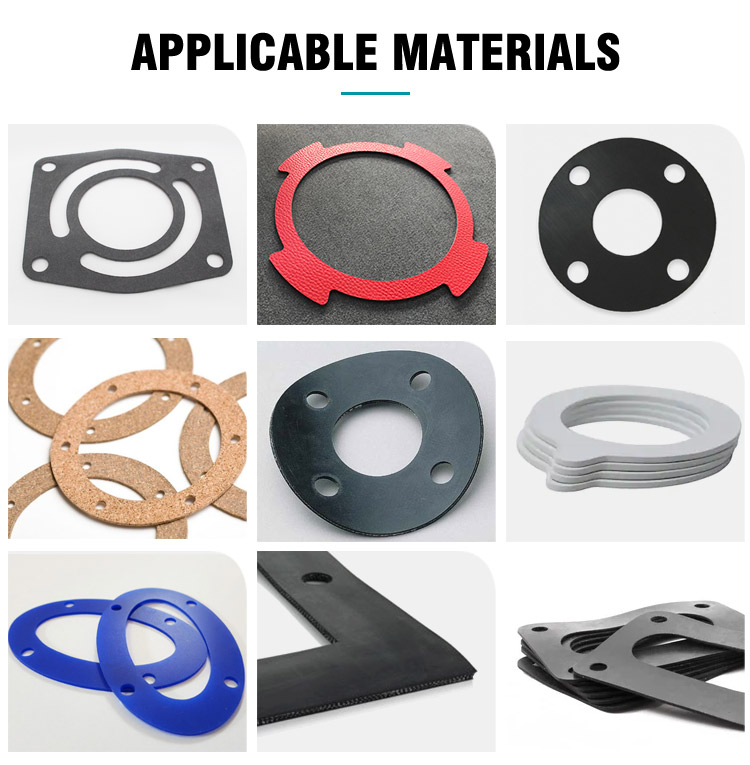In the modern manufacturing industry, sealing gaskets, as key sealing components in industrial equipment, are widely used in the fields of automobiles, petrochemicals, electricity, aerospace, and machinery manufacturing. The traditional gasket processing method relies on mold stamping, which is not only time-consuming and labor-intensive, but also inefficient and costly in small batches and diversified orders. In order to solve this pain point, CNC automatic gasket cutting machines came into being and became an important tool for the sealing industry to move towards automation and digitalization.
AOL CNC gasket cutting machine is a special equipment for cutting sealing materials. It adopts high-frequency vibration cutting technology and is suitable for a variety of gaskets such as rubber, asbestos, silicone, etc. Its core advantage lies in the high-frequency reciprocating motion of the vibrating cutter head (the vibration frequency can reach tens of thousands of times per minute). There is no open flame and high temperature during cutting, which avoids deformation of the material due to heat damage and ensures that the sealing performance is not affected. Our gasket cutting machine is equipped with a CNC system, supports the import of CAD drawings, and realizes precise cutting of complex shapes. The error can be controlled within 0.1mm, which greatly improves processing efficiency and consistency. It is widely used in production fields such as automotive pipelines and mechanical seals.

The fully automatic CNC gasket cutting equipment needs to complete the following aspects before cutting:
Material selection
Common gasket materials include rubber, silicone, polytetrafluoroethylene, etc. Before cutting, it is crucial to choose the right material, and the performance standards and expected usage scenarios of the gasket need to be considered. For example, in high temperature and strong corrosive environments, polytetrafluoroethylene gaskets are more suitable than rubber gaskets. Generally, rubber materials can meet most industrial sealing needs.
After selecting the raw materials, the materials need to be fully inspected. Make sure the surface is flat and check for defects such as cracks, bubbles, impurities, etc. Any defects will affect the cutting quality and the performance of the gasket. In addition, the material thickness should be measured to ensure that it meets the design requirements. For coils, they need to be flattened to avoid wrinkles, otherwise it will affect the cutting of subsequent processes.
Design CAD drawings
Use professional CAD software to draw accurate CAD drawings according to the design size and shape of the gasket. During the drawing process, attention should be paid to the dimensional accuracy of the graphics. The error should be controlled within a very small range to ensure that the cut gaskets meet the use standards. For gaskets with complex shapes, 3D models can be imported and CAD projection conversion can be performed to ensure the accuracy of the graphics. After the drawing is completed, the graphics are saved in a file format that our gasket CNC cutting machine can recognize, such as DXF, PLT, etc.
Machine inspection
Before starting cutting, the gasket CNC cutting machine should be inspected. Clean up the debris on the work surface to prevent these debris from affecting the positioning and cutting accuracy of the material during the cutting process. At the same time, when the equipment is not cutting and running, the various components of the equipment, including the tool holder, guide rails, transmission devices, etc., should be checked for looseness, wear, etc. If there is any abnormality, it should be tightened and repaired in time. In addition, the lubrication system of the equipment should be checked to ensure that all moving parts are fully lubricated to ensure the normal operation of the equipment.
What aspects should be set before using the gasket cutting machine?
Tool selection
In order to cut gaskets of different materials, thicknesses and hardnesses, our gasket cutting machine can be equipped with electric vibration knives, pneumatic knives, milling cutters and other cutting tools.
Blade selection
Our gasket cutting machine can cut gaskets of different thicknesses and shapes. The blade thicknesses are 0.63mm, 1mm, and 1.5mm.
Generally speaking, the thicker the gasket, the higher the hardness, and the thicker the blade
In addition, in order to cope with graphics of different sizes, the vibration blade also has different widths. For small-sized arcs, you can choose a blade with a smaller width.
Install the blade
Choose a suitable vibration knife tool according to the characteristics and thickness of the gasket material. Different materials and thicknesses require tools of different types and specifications. For example, when cutting thicker rubber materials, you need to use a tool with higher hardness and sharper blades. When installing the tool, please turn off the power of the equipment first to ensure safe operation. According to the requirements of the equipment manual, correctly install the tool on the tool holder and tighten it to ensure that the tool is firmly installed and will not loosen or fall off during cutting. After the installation is completed, check whether the tool is installed correctly and whether the tool swings flexibly.
Parameter setting
Reasonably determine the cutting parameters, mainly the cutting speed, according to the type and thickness of the gasket material. Generally speaking, the harder and thicker the material, the slower the speed should be set. When cutting thinner rubber materials, you can choose a faster speed; when cutting thicker or harder rubber, asbestos and other materials, you should choose a speed that can cut smoothly. After setting the parameters, first test cut on a small piece of material, observe the cutting effect, and adjust the parameters until the desired cutting state is achieved.
After the cutting is completed, wait for the tool to stop completely and move the crossbeam to the rear end of the machine. Remove the cut gasket from the work surface. During the removal process, be careful to avoid damage to the gasket, especially for some gaskets with complex shapes and thin edges, be more careful to prevent tearing, deformation, etc.
Perform a comprehensive inspection of the quality of the cut gasket. First, check whether the size meets the design specification requirements. Use measuring instruments such as calipers and micrometers to measure key dimensions such as length, width and thickness of the gasket to check whether the dimensional error is within the allowable range. Secondly, check whether the cutting edge of the gasket is neat and whether there are defects such as burrs and seams. If there are quality problems in the gasket inspection results, it is necessary to analyze the cause of the problem. Is it due to improper cutting parameter settings, tool wear, or quality problems of the material itself? Take appropriate measures to correct the problem.
After the cutting work is completed, clean the gasket making machine. Remove the debris and waste left on the work surface, clean the tool, guide rails and other parts, and remove surface stains and cutting residues. At the same time, check the various parts of the equipment. If there are damaged or severely worn parts, please replace them in time. After cleaning the equipment, please clean up the work site, collect waste materials by category, and keep the work environment clean.
Application industry scenarios:
Automobile manufacturing industry: used for batch cutting of seals, gaskets, and thermal insulation pads;
Petrochemical industry: suitable for flange sealing gaskets and pipeline interface gaskets;
Electric power/equipment manufacturing: cutting of electrical equipment sealing gaskets and transformer gaskets;
Machinery processing plant: rapid processing of various special-shaped sealing gaskets;
Military industry, aerospace, shipbuilding, etc.: cutting of customized gaskets made of high-performance materials.

As the manufacturing industry transforms towards flexibility and intelligence, CNC automatic gasket cutting machines are gradually replacing traditional stamping methods and becoming the core equipment for small and medium-volume, customized sealing gasket processing. Whether you are an enterprise pursuing efficient production or a sealing manufacturer focusing on diversified product development, this equipment will be your ideal choice for moving towards intelligent manufacturing.






 No.5789, Yushan Road, Jinan City, Shandong Province, China
No.5789, Yushan Road, Jinan City, Shandong Province, China +86 18560162709
+86 18560162709 250109
250109








